Dutch coach Eric Verboom is one the most experienced hockey trainers having worked in multiple countries for both youth and top hockey. Currently he’s the head coach for the HC Den Bosch men’s team in the Dutch Hoofdklasse and assistant with the German men’s national team. In a recent article from hockey.nl he talked about his 10 rules for trainers. The ones below are based upon his thoughts on this.

1. Make sure you show enthusiasm
Make sure and show (!) you’re excited to be there as their trainer. Be active & involved. Be loud. Encourage. Be the ref. Make sure they get your full and undivided attention from beginning to end. Make sure you did everything within your power so players at the end of practice will say they had fun.

2. Every warm-up is with ball and stick and has a learning topic
Be creative from the start with your warm up drills. Always include ball and stick. Whenever possible make sure the warm up is already tied in with the specific goal or learning topic for that practice session.
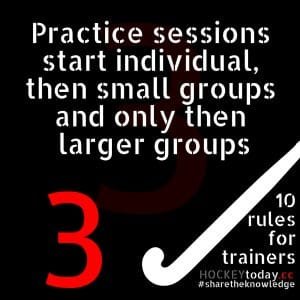
3. Practice sessions start individual, then small groups and only then larger groups
Start off with some individual drills. Especially when you’re training the youngest youth. Every player with their own stick and ball. Then go to 1v1 and build up to small sided games and only after several of these drills could you include some with larger groups. Build up the focus.
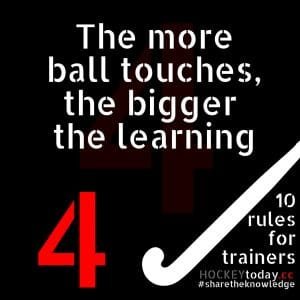
4. The more ball touches, the bigger the learning
Get your players to each have as many ball touches as possible. Avoid having players waiting in line. Create a longer circuit if you see players waiting in line. Make sure you have enough balls and build up your circuit so you waist little time in collecting balls to start over.
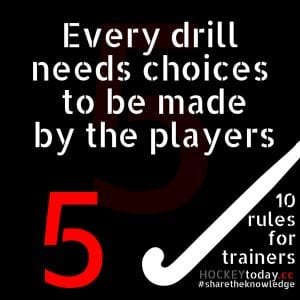
5. Every drill needs choices to be made by the players
Make sure in every drill your players need to make their own choices instead of just following the path you created for them. Challenge your players to think for themselves. Maybe do not explain all options beforehand. Small sided games ar the best drills because new situations will always come up. Be creative with (and switch up) the rules to make them think about the topics you had in mind for the drill and practice session. For example: no talking allowed for the players (encourage pre-scanning), add an extra player all of sudden or call out a name to switch teams…
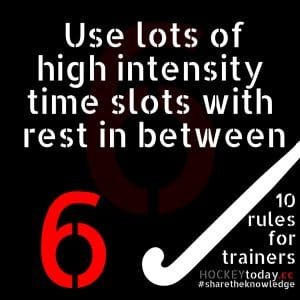
6. Use lots of high intensity time slots with rest in between
Divide your drill into multiple high intensity time slots with short breaks in between (rest & fluids). If you have 20 minutes for a drill for example it’s better to do 4×4 minutes then 2x 9 minutes. Make sure you or your staff are feeding the balls into these drills so players do not lose momentum when a ball goes out of play. Keep the tempo high.

7. Variation, variation, variation!
Change little things in your drills to avoid becoming boring and predictable. Do something new and unexpected during a drill. Throw in an extra defender or striker, especially during conversions.
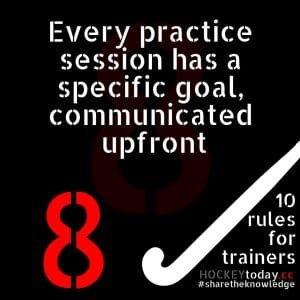
8. Every practice session has a specific goal, communicated upfront
Make sure every practice session has a specific goal. Aligned with your weekly goals and year plan build up obviously. If you have multiple sessions every week it could be a good idea to start the week with individual work. Have your strikers focus on receiving and scoring, have your defenders focus on duels and passing, etc… And build towards the last session of that week with more tactical and team focussed drills. But always make sure you have a theme and work towards a goal and communicate these.
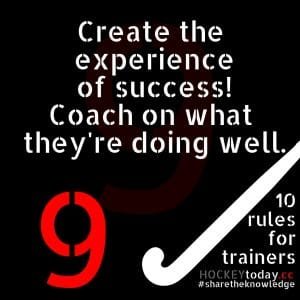
9. Create the experience of success! Coach on what they’re doing well.
Avoid negative coaching. Focus your encouragements on the things players do well. Do provide honest feedback but focus on improving. Focus on the solution instead of the problem.
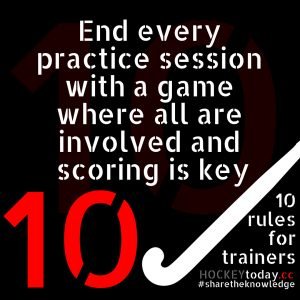
10. End every practice session with a game where all are involved and scoring is key.
Don’t end your practice session with a game just because it’s fun or a custom. Make these count. Add the elements from your learning topic that session. Involve all and make sure scoring is a big part of it. Change up the size of field or rules to make it a real part of your practice towards a certain goal and not just another game. Make sure everybody gets a lot of ball touches. Play hard. Play to win. Have fun!
Thanks to Eric Verboom for allowing us to #sharetheknowledge with his “10 rules for trainers” 😉
Follow Eric on instagram: @verboomeric and on twitter: @ericverboom.


One Response
i will change on the warm up cause most of the time we do running a lot with a ball and we don’t have more touches on the ball. thanks for the information